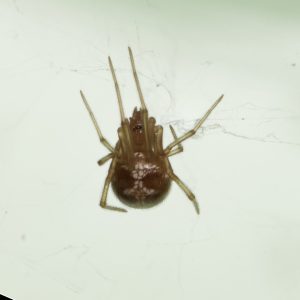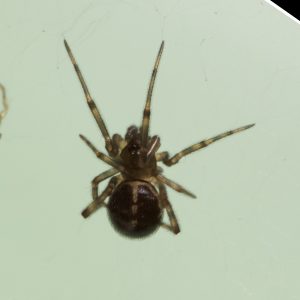Now for something totally different. I’m gearing up for a project in which I track the developmental progression of pigmentation in juvenile spiders, and along the way, also map out variation in that pigment. Analyzing all that will require a fair amount of data; I’ll have to do a daily collection of pigmentation images for a single cohort of spiders, and organize those for analysis. I have a poor idea of how much time that will take, so I did a speedrun this morning. I lined up 6 containers of juvenile spiders (all S. triangulosa from the same clutch, plus one S. borealis of roughly the same age), and racked them up for fast photography. I gave myself 30 seconds per spider to get a photo series, which turned out to be easily done, the fastest part of the whole process.
Then I took all the images and made a focus stack, which took a while but since it was all automated was fairly painless. Then I rotated all the images to the same orientation, anterior upwards. First glitch: some of the spiders were annoying and presented a side view to me, rather than the dorsal view I wanted. I went with it anyways; the only way to get them to oblige is to catch them in repose in the appropriate position, so that’s going to take a couple of trials to get right. Next, everything was scaled to the same size.
Data collection: a few minutes. Processing the images: over an hour. I think I’ll be able to automate some of the processing, though, which ought to simplify and speed it up. The end result is a series of standardized images of 6 spiders in which I can see the dorsal pigmentation fairly well, although two of them were not compliant about lying in an optimal position.
I think I’ll be able to do this. Now I just need a fresh clutch of spiderlings to hatch out — I’ve got a few egg cases waiting — and then get into a routine of spending ten minutes on photography at the same time each day, then an hour or so at my leisure processing them, and then I’ll be able to do some tracking over time of pigmentation. This is all doable! And fun! I hope. This would be a good time for the next hatch to emerge so I can do a full cohort over the Christmas break, because it just isn’t the holidays if I’m not spending Christmas day over a microscope.








That last one doesn’t count because it’s a different species, but all the others are siblings, and look at the difference between #3 and #4.
If you kept them in clear spherical containers, you would always be able to rotate them to your preferred orientation.
Spherical plastic containers mess up the optics, you want at least a flat plane, and preferably you don’t photograph through plastic at all. I have them resting in clear plastic cubes, so that they assume the pose at rest that I want; then I pop off the lid and photograph them from above. Usually they don’t mind a change in orientation, but sometimes they get agitated and decide to go haring off somewhere else.
They kind of look like they have different (illegible) Chinese characters painted on their abdomens.
If you need to autocrop, resize, sequentially name, a bunch of images, irfanview is pretty good for most operations. I use cringe-inducing .BAT files and ffmpeg for automation without a user interface.
White lucite display boxes are also a cool way of photographing small objects – the light inside is very soft and even.
What are you planning to use for automating image analysis?
We use plantcv (https://plantcv.danforthcenter.org/) for building custom image analysis pipelines, might be worth some play time to see if you like it.
@7, what an interesting project plantCV looks to be. And one thing that I picked up skimming its front page: they support IR imaging. Apparently infrared views are a thing in plant morphology? Which raises an interesting question for PZ: how do the spiders look in IR? Do spiders have IR vision? Because if so, their coloration in IR might be as important as in visible light…
[blockquote]Apparently infrared views are a thing in plant morphology?[/blockquote]
The way I’ve seen IR imaging being used is to identify bacterial infection on leaves. If you are looking at what makes bacteria more infectious or plants more resistant, you can use IR imaging to look at how infectious an interaction is.
Random paper using something like this:
https://www.ncbi.nlm.nih.gov/pmc/articles/PMC5817087/